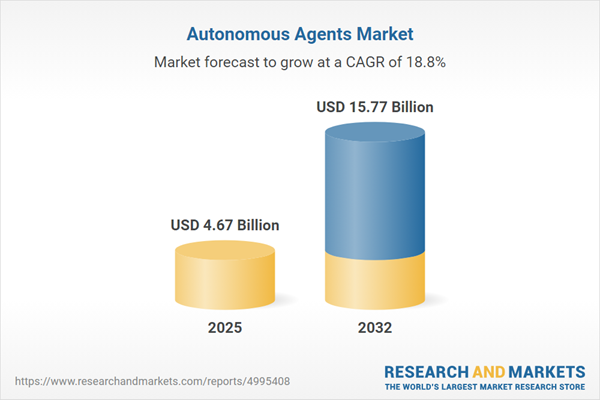Speak directly to the analyst to clarify any post sales queries you may have.
The Autonomous Agents Market is undergoing rapid transformation as enterprises leverage intelligent automation, strategic innovation, and cross-industry integration to increase operational efficiency and drive digital transformation agendas.
Market Snapshot: Autonomous Agents Market Growth and Outlook
The Autonomous Agents Market grew from USD 3.97 billion in 2024 to USD 4.67 billion in 2025. It is expected to continue growing at a CAGR of 18.79%, reaching USD 15.77 billion by 2032. This expansion signals a significant shift in artificial intelligence adoption across sectors, with organizations seeking scalable, adaptive systems that deliver measurable business gains and operational efficiencies.
Scope & Segmentation: In-Depth Autonomous Agents Market Analysis
- Component: Hardware (Actuators, Connectivity Modules, Processors, Sensors), Services (Data Annotation & Training Services, Development & Integration Services, Maintenance & Support, Security & Compliance Consulting), Software (AI Algorithms, Application Software, Operating Systems)
- Autonomy: Fully Autonomous, Semi-Autonomous
- Deployment Mode: Cloud, On-Premise
- Organization Size: Large Enterprises, Small & Medium Enterprises
- End-Use Industry: Banking & Finance, Education, Healthcare, Media & Entertainment, Military & Defense, Retail, Transportation & Logistics
- Application: Autonomous Vehicles, Customer Support/Chatbots, Healthcare Autonomous Agents, Industrial Automation Robots, Personal Assistants
- Regions: Americas (United States, Canada, Mexico, Brazil, Argentina, Chile, Colombia, Peru), Europe, Middle East & Africa (United Kingdom, Germany, France, Russia, Italy, Spain, Netherlands, Sweden, Poland, Switzerland, United Arab Emirates, Saudi Arabia, Qatar, Turkey, Israel, South Africa, Nigeria, Egypt, Kenya), Asia-Pacific (China, India, Japan, Australia, South Korea, Indonesia, Thailand, Malaysia, Singapore, Taiwan)
- Key Companies: Affectiva, Inc., Amazon Web Services, Inc., Aurora Innovation Inc., Baidu Inc., BMW Group, Boston Dynamics, Inc., Cisco Systems Inc., Cruise LLC, Fetch.ai Limited, Google LLC by Alphabet Inc., Hyundai Motor Group, Infosys Limited, Intel Corporation, International Business Machines Corporation, iRobot Corporation, Mercedes-Benz Group, Microsoft Corporation, Nuance Communications, Inc., NVIDIA Corporation, Oracle Corporation, Salesforce, Inc., SAP SE, SAS AB, SoftBank Robotics Group Corp., Tesla Inc., Toyota Motor Corporation
Key Takeaways: Strategic Insights for Senior Decision-Makers
- Market momentum is propelled by advancements in machine learning, expanded computing power, and widespread sensor integration enabling intelligent automation across complex environments.
- Organizations deploy autonomous agents to optimize processes, lower costs, and enhance customer engagement through data-driven decision-making.
- Transition from rule-based systems to adaptive, learning-driven architectures allows greater flexibility and performance in unstructured scenarios.
- Cross-industry collaborations and regulatory harmonization support interoperability and responsible deployment, driving adoption in traditional and emerging markets.
- Continuous monitoring, explainable AI frameworks, and cloud-edge integration are becoming increasingly important to ensure trust and security in autonomous systems.
Tariff Impact: Navigating the 2025 U.S. Tariffs
- New tariffs on hardware components in 2025 prompted reassessment of sourcing and manufacturing strategies, raising costs and lengthening procurement timelines for exporters and technology providers.
- Stakeholders have increased investments in domestic chip manufacturing and software innovation, advancing both supply chain resilience and the prominence of software-driven efficiencies.
- The tariff environment has contributed to regional diversification and the emergence of alternative supply partnerships, influencing rollout schedules and local manufacturing priorities in global markets.
Methodology & Data Sources
This report is grounded in layered primary research, including executive interviews and structured sector surveys, complemented by rigorous reviews of academic literature, regulatory filings, and proprietary market intelligence databases. Key findings are validated through expert workshops and iterative feedback loops, ensuring the highest quality insights.
Why This Report Matters
- Provides in-depth, segment-level analyses to inform technology adoption and investment strategies.
- Highlights regulatory, supply chain, and cross-industry integration trends critical for market resilience and competitive positioning.
- Enables senior leaders to benchmark organizational readiness and plan for scalable, secure autonomous agent deployment.
Conclusion
The Autonomous Agents Market is evolving with automation, intelligence, and regional adaptation driving business value. Industry leaders prepared to align innovation, ethics, and scalability will capture the full spectrum of opportunities within intelligent automation ecosystems.
Additional Product Information:
- Purchase of this report includes 1 year online access with quarterly updates.
- This report can be updated on request. Please contact our Customer Experience team using the Ask a Question widget on our website.
Table of Contents
3. Executive Summary
4. Market Overview
7. Cumulative Impact of Artificial Intelligence 2025
Companies Mentioned
The companies profiled in this Autonomous Agents market report include:- Affectiva, Inc.
- Amazon Web Services, Inc.
- Aurora Innovation Inc.
- Baidu Inc.
- BMW Group
- Boston Dynamics, Inc.
- Cisco Systems Inc.
- Cruise LLC
- Fetch.ai Limited
- Google LLC by Alphabet Inc.
- Hyundai Motor Group
- Infosys Limited
- Intel Corporation
- International Business Machines Corporation
- iRobot Corporation
- Mercedes-Benz Group
- Microsoft Corporation
- Nuance Communications, Inc.
- NVIDIA Corporation
- Oracle Corporation
- Salesforce, Inc.
- SAP SE
- SAS AB
- SoftBank Robotics Group Corp.
- Tesla Inc.
- Toyota Motor Corporation
Table Information
| Report Attribute | Details |
|---|---|
| No. of Pages | 199 |
| Published | November 2025 |
| Forecast Period | 2025 - 2032 |
| Estimated Market Value ( USD | $ 4.67 Billion |
| Forecasted Market Value ( USD | $ 15.77 Billion |
| Compound Annual Growth Rate | 18.7% |
| Regions Covered | Global |
| No. of Companies Mentioned | 27 |









